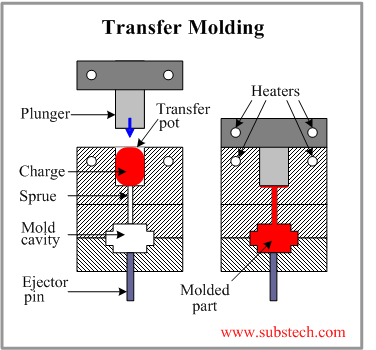Main page
About us
Sliding Bearings Consulting
Advertising Opportunities

to Polymers
to Methods of polymers fabrication
Transfer molding of polymers
Dr. Dmitri Kopeliovich
Transfer Molding (Resin Transfer Molding) is a process in which a pre-weighed amount of a polymer is preheated in a separate chamber (transfer pot) and then forced into a preheated mold through a sprue, taking a shape of the mold cavity and performing curing due to heat and pressure applied to the material.
The method is used primarily for molding thermosetting resins (thermosets), but some thermoplastic parts may also be produced by Transfer Molding.
The picture below illustrates the Transfer Molding Process.
The method uses a split mold and a third plate equipped with a plunger mounted in a hydraulic press.
The method combines features of both Compression Molding (hydraulic pressing and the same molding materials - thermosets) and Injection Molding (ram-plunger and filling the mold through a sprue).
Transfer Molding process involves the following steps:
- A pre-weighed amount of a polymer mixed with additives and fillers (charge) is placed into the transfer pot.
The charge may be in form of powders, pellets, putty-like masses or pre-formed blanks.
The charge is heated in the pot where the polymer softens.
- The plunger, mounted on the top plate, moves downwards, pressing on the polymer charge and forcing it to fill the mold cavity through the sprue.
The mold, equipped with a heating system, provides curing (cross-linking) of the polymer (if thermoset is processed).
- The mold is opened and the part is removed from it by means of the ejector pin.
If thermosetting resin is molded, the mold may be open in hot state – cured thermosets maintain their shape and dimensions even in hot state.
If thermoplastic is molded, the mold and the molded part are cooled down before opening.
- The scrap left on the pot bottom (cull), in the sprue and in the channels is removed. Scrap of thermosetting polymers is not recyclable.
Transfer Molding cycle time is shorter than Compression Molding cycle but longer than Injection Molding cycle.
The method is capable to produce more complicated shapes than Compression Molding but not as complicated as Injection Molding.
Transfer Molding is suitable for molding with ceramic or metallic inserts which are placed in the mold cavity. When the heated polymer fills the mold it forms bonding with the insert surface.
Transfer molding of thermosets is used for molding parts encapsulating metal inserts, wear plates, pins, studs, electronic components with molded terminals. Transfer molding is also used for manufacturing radio and television cabinets and car body shells.
Materials commonly processed by Compression Molding are:
- Vinylester
Related internal links



